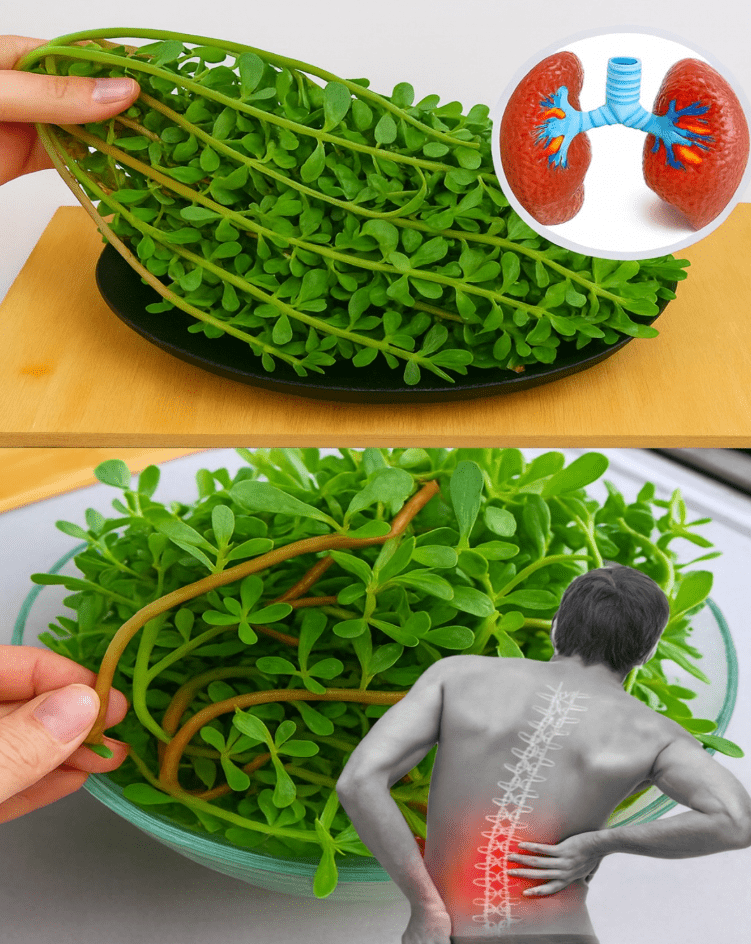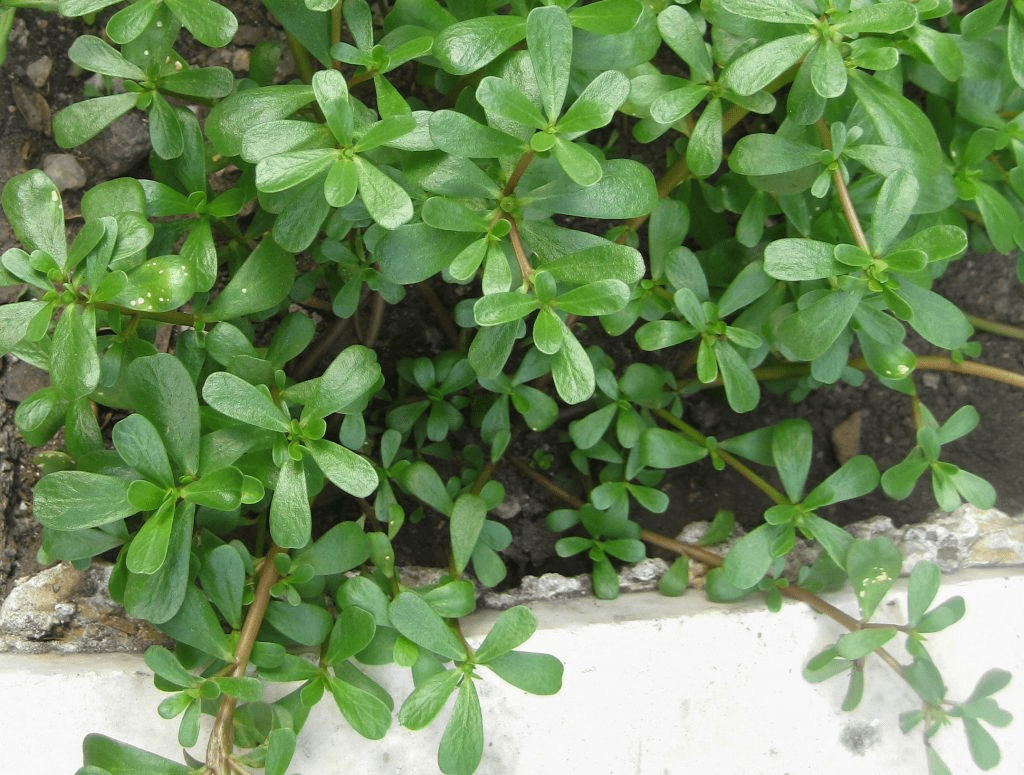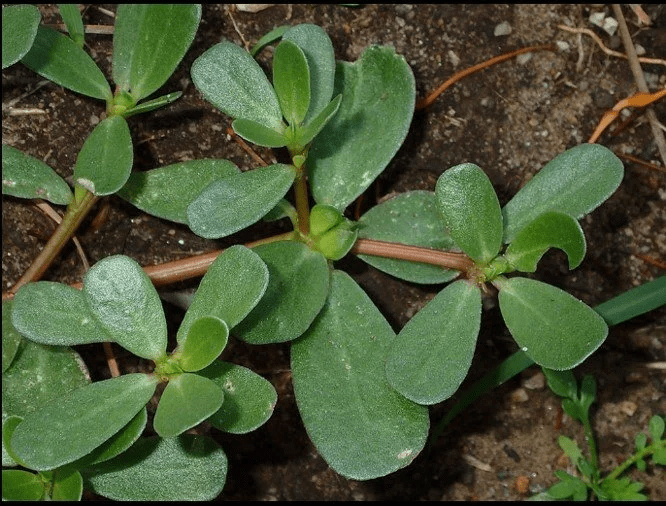
Purslane: A Natural Support for Lungs and Back Health

When it comes to nutrition, the most powerful allies for our health are often the most overlooked. Purslane—sometimes dismissed as a common garden weed—is one such example. Yet, this humble plant is one of the richest natural sources of omega-3 fatty acids among leafy greens and has been used in traditional medicine for centuries. Today, science is beginning to confirm what many cultures already knew: purslane is more than a weed; it may play a role in supporting overall health, including the lungs and the back.

In this article, we’ll explore the nutritional profile of purslane, how it may support lung function and musculoskeletal strength, and practical ways to add it to your diet.
What Makes Purslane Special?
Purslane (Portulaca oleracea) grows almost anywhere—from gardens to sidewalks—and thrives in warm climates. Far from being a nuisance, it’s a nutrient powerhouse. A 100-gram serving contains:
- High levels of alpha-linolenic acid (ALA), an omega-3 fatty acid known to support cardiovascular and inflammatory balance.
- Significant amounts of vitamin A, vitamin C, and vitamin E, all powerful antioxidants.
- Magnesium, potassium, and calcium, minerals that play critical roles in muscle and bone health.
- Beta-carotene and glutathione, compounds that help neutralize oxidative stress.
This combination makes purslane a versatile food for both respiratory and musculoskeletal support.
Purslane and Lung Health
Lung health is often challenged by pollution, smoking, allergens, and infections. Oxidative stress and chronic inflammation are central to many respiratory problems. Purslane’s properties may offer indirect support:

- Anti-inflammatory potential: Omega-3 fatty acids in purslane may help reduce inflammatory pathways, potentially easing respiratory irritation.
- Antioxidant protection: Vitamins A, C, and E contribute to protecting lung tissue from oxidative damage.
- Traditional uses: In some traditional systems of medicine, purslane has been used in teas or decoctions to soothe coughs and promote easier breathing.
Although research is still emerging, these nutritional qualities suggest that adding purslane to the diet may be a supportive measure for lung wellness.
Purslane and Back Health
A strong back depends on healthy muscles, bones, and connective tissues. Purslane contributes in several ways:
- Magnesium and potassium help regulate muscle contractions and reduce the risk of cramps and stiffness.
- Calcium supports bone strength, crucial for spinal health.
- Omega-3s may help reduce inflammation in joints and connective tissues, which can indirectly ease back discomfort.
- Antioxidants may play a role in slowing age-related degeneration in musculoskeletal tissues.
Together, these nutrients may provide a natural foundation for maintaining spinal flexibility and resilience.
How to Use Purslane in Your Diet

Purslane’s slightly tangy, lemony flavor makes it easy to enjoy in many dishes:
- Fresh salads: Mix purslane leaves with cucumbers, tomatoes, and olive oil for a refreshing summer dish.
- Smoothies: Add a handful of purslane to green smoothies for an omega-3 boost.
- Soups and stews: Purslane can be added toward the end of cooking to retain its texture and nutrients.
- Stir-fries: Quickly sauté purslane with garlic and ginger for a simple side dish.
- Traditional recipes: In Mediterranean and Asian cuisines, purslane is often used in yogurt dips, omelets, or pickles.
Here’s a quick overview:
| Preparation Method | Benefit | Example Dish |
|---|---|---|
| Raw | Maximum vitamin C and antioxidants | Salad or smoothie |
| Lightly cooked | Softer texture, retains minerals | Stir-fry, soup |
| Fermented/pickled | Preserves nutrients, adds probiotics | Purslane pickle |
Safety and Precautions
While purslane is generally safe, there are a few considerations:
- It contains oxalates, which may contribute to kidney stones in sensitive individuals.
- As with any new food, start with small amounts to see how your body responds.
- Pregnant or breastfeeding women should consult a healthcare provider before making it a regular part of their diet.
Conclusion: A Small Plant with Big Potential

Purslane may be small and often overlooked, but it is packed with nutrients that can support both lung health and musculoskeletal resilience. By providing omega-3 fatty acids, antioxidants, and minerals, purslane offers a natural way to nourish the body from the inside out. Adding it to your meals a few times a week could be a simple yet meaningful step toward breathing easier and moving with strength.
FAQ
Is purslane safe to eat raw?
Yes, purslane can be eaten raw, but wash it thoroughly to remove dirt and pesticides.
Can purslane replace supplements for omega-3s?
It’s a good plant-based source, but it may not provide the same levels as fish oil. It can, however, complement other dietary sources.
How often should I eat purslane?
A few servings per week can add variety and nutrients, but balance with other leafy greens.
Does purslane help with chronic back pain?
It’s not a treatment but may support overall muscle and bone health, which indirectly benefits the back.
Disclaimer: This article is for educational purposes only and is not a substitute for professional medical advice. Always consult your healthcare provider before making dietary changes, especially if you have underlying health conditions.
News in the same category


Unleash Your Inner Lion: The Ultimate Egg, Honey, and Coffee Elixir for Men’s Vitality

7 Silent Sleep Killers Sabotaging Seniors’ Health (And How to Fix Them Tonight)

Moringa Unleashed: Discover the Secret Superfood That Can Revolutionize Your Health

Discover Grandma’s Secret: A Natural Remedy to Banish Varicose Veins

7 Teas That Stop Swollen Legs, Ankles, and Feet for Good

7 Powerful Ways Prosopis Juliflora Boosts Digestive and Heart Health

Indian Borage (Mexican Mint): A Herbal Drink for Eye Health

Aloe Vera Remedy: A Natural Support Against Bacteria and Fungi

Ginger, Onion, Garlic, Lemon & Honey Mix: How to Make It and Why It Matters

4 Teas for 4 Organs: Liver, Stomach, Heart & Brain

Over 60? Drink These 3 Teas to Rebuild Muscle and Walk Strong Again

Knee Pain Relief Starts with THIS Powerful Drink (Must Try for Seniors!)

Seniors, Do This 1 Simple Leg Move to Reverse Hidden Health Problems

Stronger Than Garlic and Lemon: The Bay Leaf Foot Soak That Removes Toxins and Bacteria

Herbal Tea from Stonebreaker Plant for Brain and Memory Support

I Applied Toothpaste and Vaseline on My Face – Here’s What Happened

Parsley Juice for Kidney Cleansing and Stone Relief

All-in-One Master Tonic Shots: Fire Cider with Apple Cider Vinegar, Cinnamon, Clove, Lemon, Ginger, Turmeric, Cayenne & Honey
News Post

Unveil the Mystery: 10 Japanese Rice-Based Secrets for Radiant, Wrinkle-Free Skin

Unleash Your Inner Lion: The Ultimate Egg, Honey, and Coffee Elixir for Men’s Vitality

7 Silent Sleep Killers Sabotaging Seniors’ Health (And How to Fix Them Tonight)

Moringa Unleashed: Discover the Secret Superfood That Can Revolutionize Your Health

Discover Grandma’s Secret: A Natural Remedy to Banish Varicose Veins

A Boy’s Hand Shows Strange Signs After Playing in the Sand

7 Teas That Stop Swollen Legs, Ankles, and Feet for Good

7 Powerful Ways Prosopis Juliflora Boosts Digestive and Heart Health

Indian Borage (Mexican Mint): A Herbal Drink for Eye Health

Aloe Vera Remedy: A Natural Support Against Bacteria and Fungi

Ginger, Onion, Garlic, Lemon & Honey Mix: How to Make It and Why It Matters

4 Teas for 4 Organs: Liver, Stomach, Heart & Brain

Over 60? Drink These 3 Teas to Rebuild Muscle and Walk Strong Again

Knee Pain Relief Starts with THIS Powerful Drink (Must Try for Seniors!)

Seniors, Do This 1 Simple Leg Move to Reverse Hidden Health Problems

Stronger Than Garlic and Lemon: The Bay Leaf Foot Soak That Removes Toxins and Bacteria

Herbal Tea from Stonebreaker Plant for Brain and Memory Support

I Applied Toothpaste and Vaseline on My Face – Here’s What Happened
